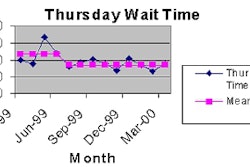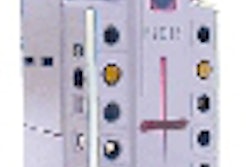The Hospital Outpatient Prospective Payment System (HOPPS) can be a bitter brew for U.S. healthcare facilities to swallow. Reimbursement dollars under the plan may be lower than current numbers, cutting into budgets that have already been cut to the bone.
Moving outpatient radiology services off campus to an imaging center is one method of avoiding HOPPS restrictions, but most institutions are unwilling to relinquish either the control or the revenue. However, a joint venture between a facility and its radiologists to establish such centers can pay big dividends for both parties.
The Medicare payment system centers on payment groups known as ambulatory payment classifications (APCs), which categorize procedures into code sets based on the type, nature, and costs of service. Beginning in 2003, APCs will apply to all covered outpatient services, including radiology.
The expected impact on radiology is twofold. First, APC groups are packaged. For example, CT and MR scans, both with and without contrast, are incorporated into the same payment group. Second, APCs are assigned a payment weight that is multiplied by a conversion factor to produce a payment amount. However, that weight is calculated from median hospital costs as reported up to June 1997.
Although the Balanced Budget Reconciliation Act of 1999 (BBRA) requires an annual review of HOPPS components, with revisions as necessary, the 1997 base number stays the same.
"Revise does not mean rebase," said Ken Davis, a partner at the law firm of Katten Muchin Zavis in Chicago. "Unless the legislature changes the rebase number, APCs will stay on the same fee schedule," he noted.
Davis, along with Bill Sanders, vice president of operations at Regent Health Resources in Brentwood, TN, presented this gloomy payment picture at the Radiology Business Management Association (RBMA) 2001 radiology summit in Scottsdale, AZ.
"The transitional corridors, where hospitals are eligible to receive supplemental payments when HOPPS payments are less than the pre-BBRA amount, are on the decline. In fact, by 2003 the transitional corridor adjustments expire entirely," said Davis. In effect, HOPPS may well result in hospitals being reimbursed less for the technical component of hospital outpatient medical imaging.
Breaking away
Davis and Sanders proposed what may be a radical departure for many facilities in the U.S. They advocate that radiologists, and their affiliated institutions, look closely at creating a joint venture-funded imaging center outside the hospital.
"The tangible benefit to moving outpatient medical imaging to a separate entity/location, which is not provider-based, is to avoid HOPPS and maintain or increase overall reimbursement levels," Sanders said.
The intangible benefits for both the hospital and the radiologist are also compelling. The healthcare institution can access new capital and credit resources (the cash and credit-worthiness of the radiologists), as well as update equipment off its balance sheet. In addition, the radiologists can more directly apply their experience to improve how the technical component is provided, making them more competitive in the marketplace, Davis said.
For the radiologists considering such a joint venture, it is an opportunity to be more involved in the management of their profession. They will have the capability to be more involved in equipment planning and to gain income from the technical operations of the imaging center. And the financial and operational incentives of the radiologists and the hospital will be closely aligned.
Institutional inertia
Healthcare institutions tend to be very cautious and conservative entities, Sanders and Davis said. Thus, the proposal to create a joint-venture imaging center will most likely have to be generated by a hospital’s radiologists.
Sanders recommended that the radiologists prepare a detailed cost analysis, by modality and procedure, of current and prospective reimbursement schedules, as they will be affected by HOPPS. The cost analysis should also include both minimum and maximum APC values with coinsurance payments per procedure. These numbers will determine the financial impact of HOPPS on the hospital’s provision of outpatient medical imaging.
A market analysis is the next step in evaluating the feasibility of creating a joint venture. This should include an examination of reimbursement levels, both technical and professional, if medical imaging is moved into a freestanding imaging facility. Other items that need to be addressed are the financial impact on the radiologists, market competition, and the projected cost and timing of developing a new facility.
"You need to have your ducks lined up before you approach the hospital administration," said Davis. This means the radiology group should be prepared to address the following concerns:
- What capacity or modalities, if any, are the radiologists willing to contribute?
- What capital or credit resources are the radiologists willing to make available?
- Is the joint venture willing to introduce or expand current modalities to meet market needs?
- What level of management control do the radiologists’ desire?
"A joint venture must make financial sense, both in terms of HOPPS and the needs it can address within the community," noted Sanders.
Negotiation and transaction
Davis warned that even with a thorough market analysis, some institutions may balk at a joint venture imaging center deal. "The issue for many hospitals is a perceived lack of control, even if it is in its own best interest," he said.
There are issues that a hospital will haggle over, Sanders said, and they could include the following:
- The capacity and modalities to be included in the joint venture
- Control or management discretion among the parties
- Valuations
- Responsibility for contributing cash or credit resources
- Ownership percentages
- Professional service fees
- Management fees
In addition to items such as equity, management, and billing, regulatory issues must be resolved by the parties prior to forming the joint venture. Reimbursement, a certificate of need, licensure, and tax status of asset funding by the hospital are but a few of the items that need to be addressed in creating a joint venture structure.
Davis cautioned that business managers should clearly delineate and document control and management agreements between and among the parties involved.
"You’ll want to be sure to include mechanisms to handle such items as determining the need for additional capital, valuing contributions, and diluting a party that fails to contribute. You’ll also want to negotiate possible buy-out provisions in the agreement, in case one party wants to move the joint venture in a different direction than the other party," he said.
By Jonathan S. BatchelorAuntMinnie.com staff writer
July 18, 2001
Related Reading
USDL fails to make payments, July 5, 2001
Strategic marketing brings in referring physicians, June 27, 2001
US Oncology to open two more PET centers, June 20, 2001
Revenue review revitalizes reimbursement, June 19, 2001
Miracor buys two MRI centers, June 12, 2001
Click here to post your comments about this story. Please include the headline of the article in your message.
Copyright © 2001 AuntMinnie.com



















